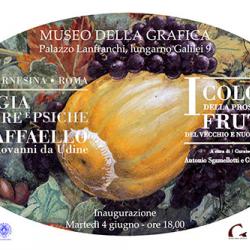
Place:
Museo della Grafica
Start date:
End date:
From June 4th to 30th the Graphic Museum hosts the exhibition "The colors of prosperity: fruits of the old and new world", which illustrates the results of an analysis campaign on the frescoes of the Loggia di Amore and Psyche of the Villa Farnesina in Rome, designed from Raphael.
The non-invasive imaging analyzes, performed with the X-ray fluorescence technique (XRF), have deepened the knowledge of the materials used and of the execution technique, highlighting aspects that have not been published until now.
The vault of the main loggia, on the inside, was frescoed according to a design by Raffaello, drawing inspiration from the fable of Amore e Psiche (from the Asino d 'Oro, by Apuleio), and was decorated with naturalistic motifs executed with extraordinary mastery by Giovanni da Udine. The richness of the plant species portrayed, in which the painter was able to use a stylistic language and an absolutely original chromatism, amounts to about one hundred and seventy botanical entities. The presence of rare and exotic species from all the then known continents is also exceptional, and in particular of American species just 20 years after the discovery of the new world.
Visitors will have at their disposal a touchscreen station to navigate between the images of the Lodge and to observe at close range the very particular arbor, distinguishing with greater ease the 170 species present in the vegetable festoons and enjoying all those pictorial details hardly observable from the normal perception distance of the time (8 meters), as well as botanical, iconographic and results obtained from imaging analyzes. The system can also be consulted on the web at the link http://vcg.isti.cnr.it/farnesina/.
The exhibition, already proposed in 2017 at Villa Farnesina, was curated by the Linceo Member Antonio Sgamellotti (professor emeritus of inorganic chemistry, University of Perugia) and by Giulia Caneva (professor of environmental and applied Botany, Roma Tre University)